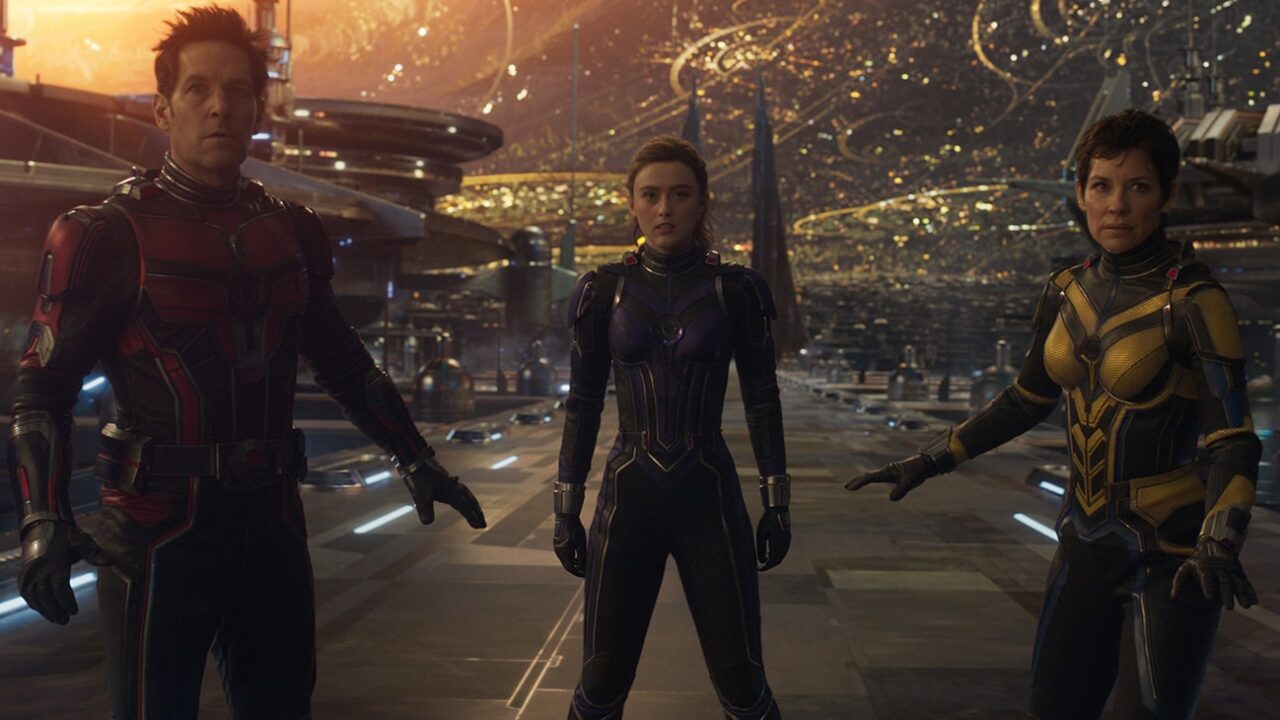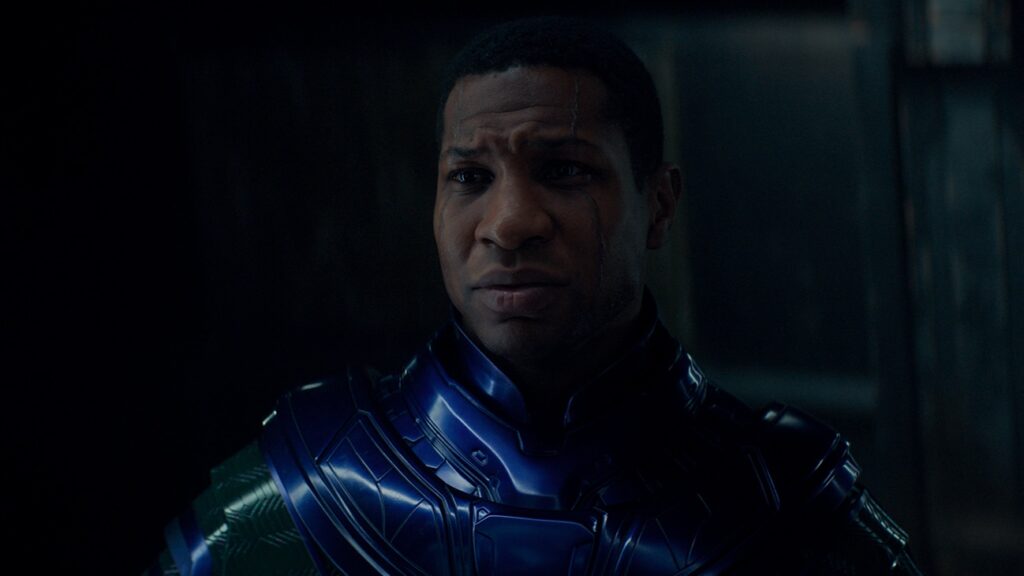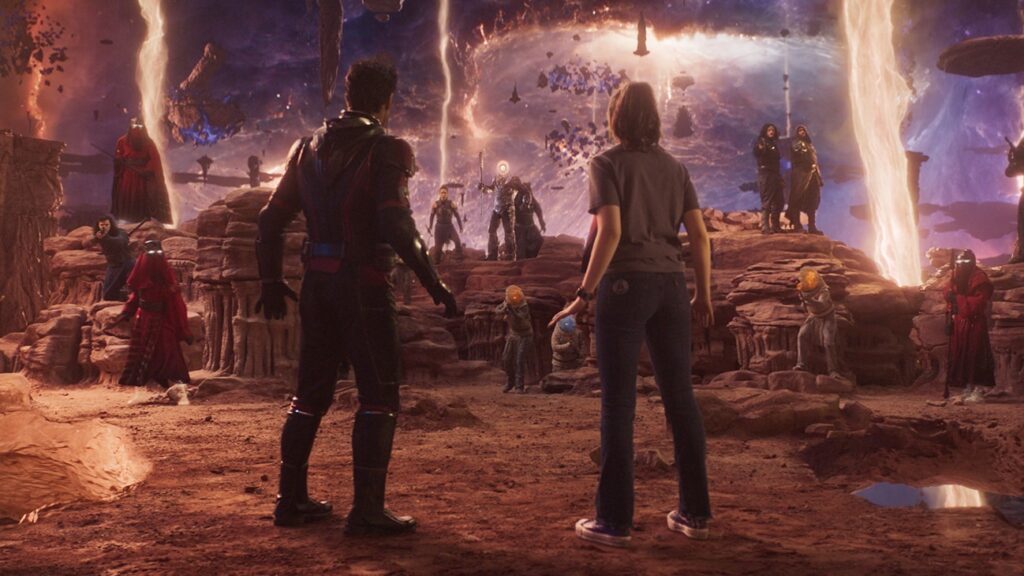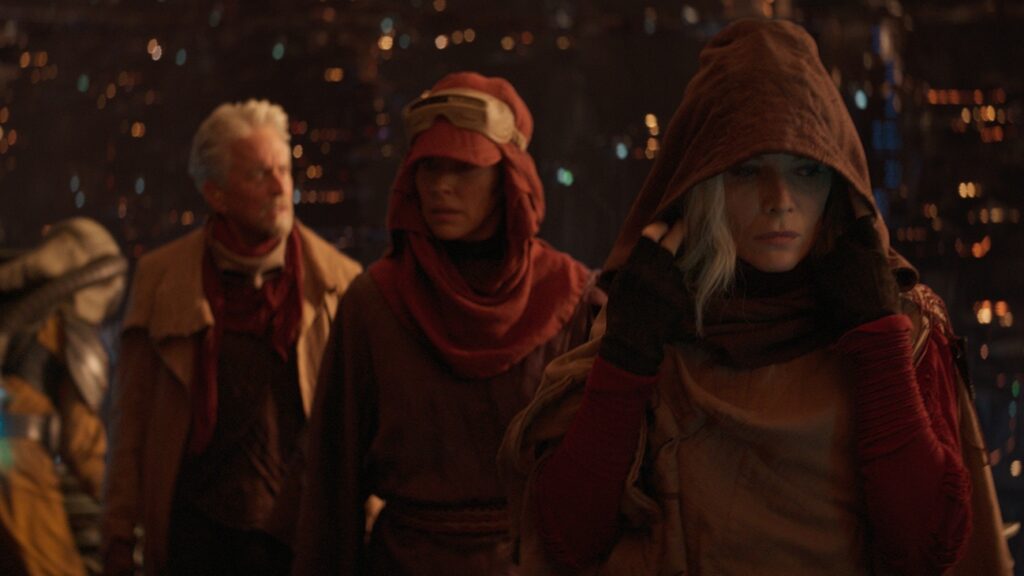Ant-Man’s Take on Policing Shows Arrested Development
Marvel’s latest is a tonally jarring fantasy and hollow political allegory. Ant-Man and the Wasp: Quantumania / Photo provided by Disney
Ant-Man and the Wasp: Quantumania / Photo provided by Disney
Ant-Man and the Wasp: Quantumania
Directed by Peyton Reed
It’s hard to know how seriously to take “Ant-Man and the Wasp: Quantumania,” because it doesn’t know how seriously to take itself. A sci-fi comedy constantly interrupted by crude teases for future sequels, Marvel’s 31st feature attempts to bridge the gap between two overarching “sagas” — its previous long-running story leading up to “Avengers: Endgame” and its next series of major crossovers. The film also tries to tell its own story, originating from comic book fictions yet still rooted in contemporary facts. Even the fantastical, child-friendly rebellion of pink goo-people against their evil emperor alludes to our ugly real-world politics. But the film’s ham-fisted treatment of these allusions reflects a familiar limitation of the Marvel Cinematic Universe, where super heroes rescue and avenge without caring much about the bigger picture, despite occasionally delivering dialogue that suggests otherwise.
Paul Rudd once again plays size-shifting hero Scott Lang/Ant-Man, who has become a happy-go-lucky celebrity in the wake of his role saving half the world’s population in “Avengers: Endgame.” During that episode, Scott was trapped in the Quantum Realm for Earth years that passed like hours for him, during which his daughter Cassie (Kathryn Newton) grew into a self-sufficient, rebellious teenager who does (off-screen) battle with the San Francisco police while defending homeless encampments populated by people who re-appeared after “Endgame” (an event labeled “the blip”).
Scott’s superhero girlfriend Hope/The Wasp (Evangeline Lily) is said to engage in some kind of nebulous humanitarian work, but she, like Scott, disapproves of Cassie’s militancy and doesn’t have much to say about the encampments. At first, the issue of policing homelessness seems like a fleeting background detail meant to establish a rift between father and daughter. But when a freak accident sends Scott, Cassie, Hope and Hope’s scientist parents, Hank (Michael Douglas) and Janet Pym (Michelle Pfeiffer) down to the Quantum Realm, it becomes a thematic linchpin for Scott and Cassie’s relationship. Like so much else, the movie fails to realize its full potential (or any of its potential, really).
Although Janet spent much of the last two “Ant-Man” movies trapped in this same realm, it never occurs to her to reveal any of its details or tribal inhabitants to her family. As a result, the characters are surprised when they’re shrunk down to subatomic size and thrust into a hidden civilization in the middle of a civil war between multi-species rebels and a technologically advanced kingdom. That kingdom’s ruler, Kang The Conqueror (Jonathan Majors), is an imposing villain with whom Janet is familiar, but since she never mentioned him to the other heroes, the narrative becomes rife with monologues and flashbacks meant to flesh out his backstory.

Kang, we learn, is a time traveler also stranded in this realm, so desperate to get the materials he needs to escape that he creates a fascist hierarchy enforced by faceless cyborg goons who oppress the realm’s indigenous tribes. Cassie, a rebel at heart, senses their plight and begs her father to look beyond himself and assist them in their fight. This brings their disconnect over her anti-policing actions full circle. The only problem is that Scott’s goals are coincidentally aligned with that of the local rebels anyway, against the evil Kang. There’s neither familial friction nor altruism involved in his hero’s journey. He opposes Kang to help rescue his own family and get them home.
Real-world analogues to the Marvel movies’ political set-pieces are highly charged, from the criminalization of homelessness in “Quantumania” to the persistence of hunger amid plenty in “Avengers: Infinity War.” And yet, the Avengers never tackle any of these persistent problems themselves. In “Captain Marvel,” Carol Danvers turns her back on her alien compatriots, the Kree, when she realizes her powers are being used to target alien refugees. When she finally discards the green and black Kree insignia, she re-fashions her costume using the red and blue of a U.S. Air Force t-shirt, since she was a former pilot. Neither the character nor the film betrays any awareness of the head-spinning hypocrisy of rejecting a fictitious violent institution by embracing its real-world equivalent. (This can be filed under the larger conversation on Hollywood’s continued ties to the Department of Defense).
Even in the rare instances in which Marvel heroes use their powers and resources for altruistic good, their actions are generally narrow, if not antisocial. In “Black Panther,” the titular hero opposes his villain’s violent methods of global Black liberation in favor of a science outreach program for a single underfunded Black neighborhood in Oakland, California. In the TV show “The Falcon and The Winter Soldier,” the villainous Flag Smashers fight for equitable housing for those displaced by “the blip” — not unlike Cassie in this film — but by framing the villains’ methods as too violent, Marvel’s creators also prove unable and unwilling to challenge their heroes or present them with the opportunity to do actual good. Predictably, that series ended with the politically muddled conclusion of Falcon vaguely lecturing world leaders about cooperation, with no follow-up on what became of the aforementioned unhoused people.

Given this pattern, it should not surprise you to learn that “Ant-Man and the Wasp: Quantumania” similarly offers zero follow-through on the problems of homelessness and police violence. The result is yet another reactionary superhero.
The social void at the core of “Ant-Man and the Wasp: Quantumania” is mirrored by the movie’s lack of visual clarity. Although the Quantum Realm is based on the comics’ Microverse, traditionally illustrated with bright, eye-popping designs, its cinematic equivalent is depicted as grey-brown sludge. Its creatures and other inhabitants are all similarly drab; every alien environment is lit with the same dull, texture-less wash. The result is a lack of any shadow or contrast that might have prevented the CGI elements from blending together, or possibly introduced some dramatic subtext to the actors’ faces, rather than lighting them like weather reporters against obvious green screens.
Real-world analogues to the Marvel movies’ political set-pieces are highly charged, from the criminalization of homelessness in “Quantumania” to the persistence of hunger amid plenty in “Avengers: Infinity War.”
Between the wide range of alien character designs, and the light orientalism of their Bedouin-inspired garb, it seems the folks at Marvel tried their hand at their version of a “Star Wars” film. (Director Peyton Reed directed two episodes of the Star Wars show “The Mandalorian”; Producer Kevin Feige, meanwhile, is slated to produce his own movie in a galaxy far, far away). However, “Star Wars” movies — whether under Disney or George Lucas — have never been this visually incoherent. “Quantumania” features so little connective tissue between its live-action and pre-visualized elements, and so little care for basic action geography, that scenes meant to feel propulsive end up disorienting instead.
What keeps “Quantumania” somewhat enjoyable despite itself is levity. When it isn’t hinting at the oncoming tragedy of future Avengers films, it remains silly, childish. Minor characters like William Jackson Harper’s matter-of-fact mind reader Quaz, or David Dastmalchian’s nervous, shapeless blob, Veb, feel plucked out of a Saturday morning cartoon (or Disney’s own pulp adventure throwback “Strange World”). And while the movie never fully reconciles its two warring tones — what it is, and what it’s advertising down the line — its humor is broad and inoffensive enough to be easily digestible. Its dialogue scenes offer needed respites from the action.

The film’s biggest redeeming quality is its cast, starting with Majors’ conception of Kang. A plain villain in the comics whose main concern is conquering all of time, Majors elevates the character’s big-screen introduction beyond what little the script provides. Other than some specific logistics, you could leave “Quantumania” knowing as little about Kang as when the movie began, but Majors turns this lack of concrete detail into a compelling mystery. He stands and walks with an imposing regality, arms gently crossed but always ready to strike. He speaks in quiet whispers that border on polite, reserving his fury and strength for the rare moments when they’re necessary, and his technology is so advanced that he may as well wield the powers of a god. And yet, there’s something deeply sorrowful and lonely about him — something Majors barely conceals beneath his expressive eyes. Wherever Kang’s megalomania stems from, it feels like evil and ambition compelled by tragedy. One can only hope this version of the character shows up in the future (rather than Marvel starting from scratch with yet another iteration played by Majors, as they already have).
If Majors is the entrée, Rudd is the dessert, with his usual brand of everyman comedic charm. The Marvel movies tend to be self-effacing, but the benefit of a character like Ant-Man is that he’s never cynical. Unfortunately, Newton, Lily and Pfeiffer are all saddled with little beyond rote, expository dialogue, so it’s difficult for them to be remarkable either way (that Lily’s character shares the title with Rudd’s is a formality at this point; she’s mostly along for the ride). However, where all the other leads are sincere and committed in their approach, Douglas manages to phone in a performance so uninterested in all the quantum junk science rattled off by Hank that it becomes absurd — and funny.
The social void at the core of “Ant-Man and the Wasp: Quantumania” is mirrored by the movie’s lack of visual clarity.
Equally absurd is Corey Stoll’s return as Darren Cross, a newly minted Marvel character from the first “Ant-Man,” who’s now been retro-fitted with the enormous cranium and tiny limbs of the comics’ M.O.D.O.K., a cyborg and Kang minion who, like Douglas, feels so out of place that he becomes amusing as well, albeit for completely different reasons. Stoll, with his face digitally stretched and half-rendered across an enormous floating skull, is saddled with cartoonish, naked sentimentality that often rubs up against the film’s more serious universe-building, courtesy of Kang and his monologues, which are sure to become relevant several films from now.
This lack of present-ness, the constant cutaways from the main characters to establish potential sequels, infects so much of the runtime that it’s hard not to see “Ant-Man and the Wasp: Quantumania” as Marvel’s longest trailer yet. In the process, its father-daughter story falls by the wayside and ends up being told through hasty character beats. This becomes all the poorer in taste due to invocations of contemporary political ugliness — i.e. the thematic mirroring between police storming homeless encampments and armed guards attacking displaced alien refugees — that yield disappointingly little by way of story, meaning or even visual comprehensibility. Viewers old enough to understand even rudimentary narratives deserve better than a handful of scattered laughs and a great deal of visual unpleasantness.
Your support matters…Independent journalism is under threat and overshadowed by heavily funded mainstream media.
You can help level the playing field. Become a member.
Your tax-deductible contribution keeps us digging beneath the headlines to give you thought-provoking, investigative reporting and analysis that unearths what's really happening- without compromise.
Give today to support our courageous, independent journalists.
"In “Black Panther,” the titular hero opposes his villain’s violent methods of global Black liberation in favor of a science outreach program for a single underfunded Black neighborhood in Oakland, California."
This is such a misconstruction/misinterpretation of the denouement of the story of the Black Panther as to appear to be nothing more than a purposeful lie. The rest of the puffery being passed off as substantive analysis in your article rates the same...
"In “Black Panther,” the titular hero opposes his villain’s violent methods of global Black liberation in favor of a science outreach program for a single underfunded Black neighborhood in Oakland, California."
This is such a misconstruction/misinterpretation of the denouement of the story of the Black Panther as to appear to be nothing more than a purposeful lie. The rest of the puffery being passed off as substantive analysis in your article rates the same response.
I think that reading into a movie as if it were a serious tome instead of a fantasy romp is a bridge too far.
That's just me though.